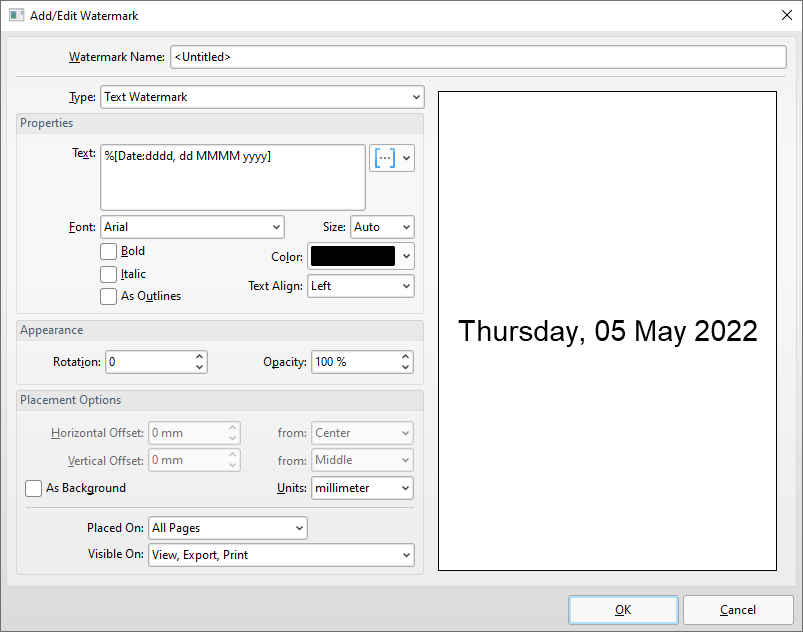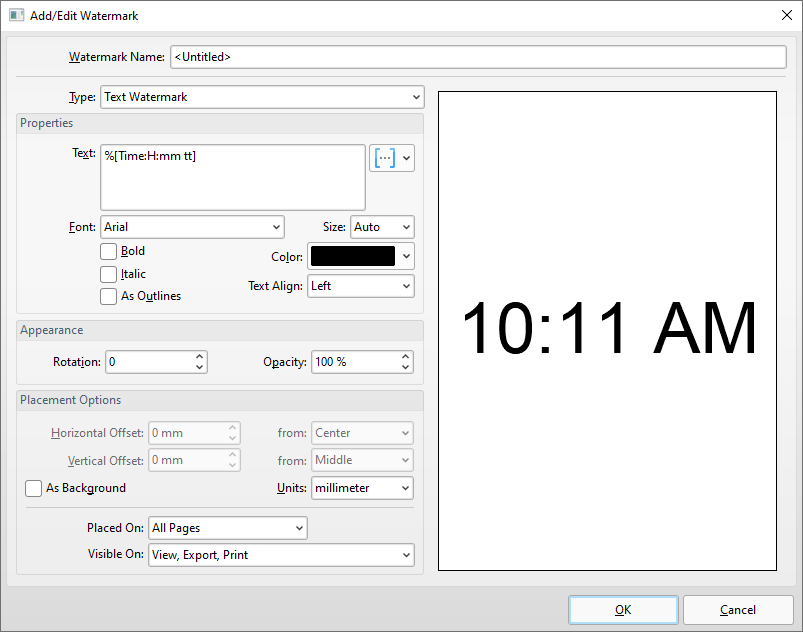 Date and Time Macros
Date and Time Macros
There are several macros in PDF-XChange Standard that are used to create date and time output. They operate in an identical manner and are often used in conjunction with each other. The date and time macros are detailed below:
%[Date]
The %[Date] macro adds the current date. The following parameters are available:
•d inserts the day of the month and omits the zero in cases of single-digit values.
•dd inserts the day of the month and includes a zero in cases of single-digit values.
•ddd inserts the day of the week as a three-letter abbreviation.
•dddd inserts the day of the week.
•M inserts the month as a numerical value and omits the zero in cases of single-digit values.
•MM inserts the month as a numerical value and and includes a zero in cases of single-digit values.
•MMM inserts the month as a three-letter abbreviation.
•MMMM inserts the month.
•yy inserts the year as two digits and adds a zero in cases of values lower than 10.
•yyyy inserts the year.
The syntax for this macro when parameters are used is %[Date:<Parameter>]
Note that several parameters can be used in sequence in order to insert a customized date. For example, %[Date:dddd, dd MMMM yyyy] inserts the day of the week followed by the day of the month, the month name in full and the year as four digits:

Figure 1. Add/Edit Watermark Dialog Box, Example %[Date] Macro
If parameters are not specified for this macro then output reverts to default, which is the the format d/M/yyyy.
%[Year]
The %[Year] macro adds the current year as a four-digit value.
%[Month]
The %[Month] macro adds the current month as a numerical value from 1-12.
%[Day]
The %[Day] macro adds the current day of the month as a two-digit value.
%[Time]
The %[Time] macro adds the current time. The following parameters are available:
•h inserts the hour and omits the zero in cases of single-digit values.
•hh inserts the hour and includes a zero in cases of single-digit values.
•H inserts the hour, includes a zero in cases of single-digit values and uses a 24 hour-clock.
•m inserts the minutes and omits the zero in cases of single-digit values.
•mm inserts the minutes and includes a zero in cases of single-digit values.
•s inserts the seconds and omits the zero in cases of single-digit values.
•ss inserts the seconds and includes a zero in cases single-digit values.
•t inserts a single character to reference the a.m./p.m. variable: A or P.
•tt inserts two characters to reference the a.m/p.m. variable: AM or PM.
The syntax for this macro when parameters are used is %[Time:<Parameter>]
Note that several parameters can be used in sequence in order to insert a customized time. For example, %[Time:H:mm tt] inserts the current hour and minutes, and inserts two characters to reference the a.m./p.m. variable:

Figure 2. Add/Edit Watermark Dialog Box, Example %[Time] Macro
%[Hour]
The %[Hour] macro adds the hour value from the current time.
%[Minute]
The %[Minute] macro adds the minute value from the current time.
%[Seconds]
The %[Seconds] macro adds the second value from the current time.
Note that these macros can be combined as desired.